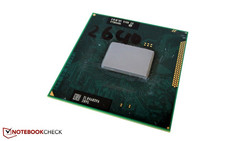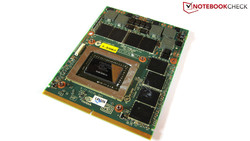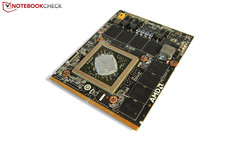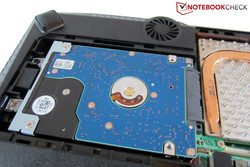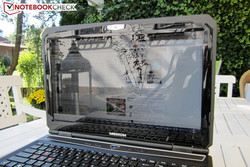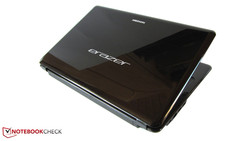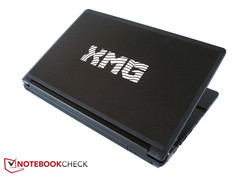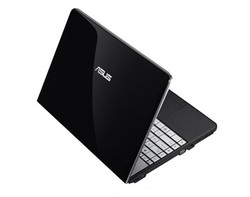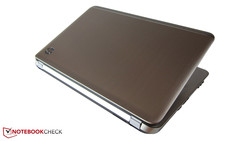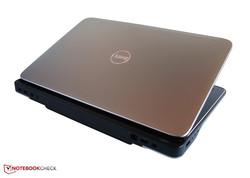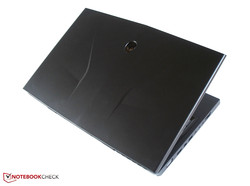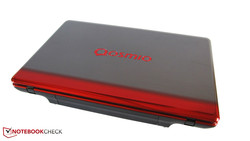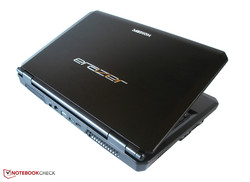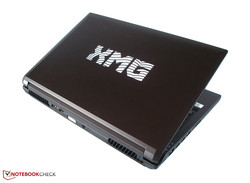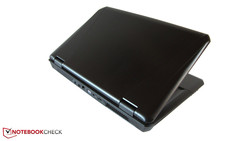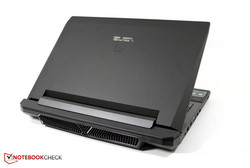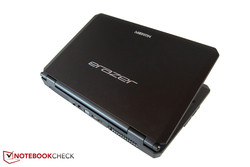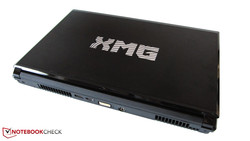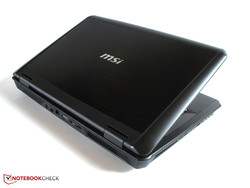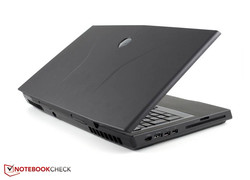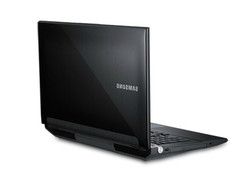Market Overview - Gaming Notebooks 2011
Gaming notebooks are loved by manufacturers and users alike. These high-end mobile platforms perform at the same level as the giant PC towers. So why let a big PC hog all the desk space when a laptop could do the same job? Gaming notebooks are for buyers who are not afraid to dig deep into their pockets to pay for a gaming machine packed into a portable format. Prospective buyers will find a suitable gaming laptop in this market overview.
We limited the number of candidates for this article so as not to overwhelm the reader with information. Our pick includes 16 gaming notebooks which all have an Intel Sandy Bridge processor, the latest DirectX 11 graphic card from AMD (6000-series) or Nvidia (500-series) and a 14 to 17 inch (diagonally) display. Laptops with smaller screens were excluded from this article as they cannot provide a rich atmosphere and clear overview for the user. We also excluded systems running dual graphic cards setups as they have various disadvantages, such as high costs, emissions, driver dependence, "micro-stutters", etc.
Tips
We have put together a few basic tips and information for the reader. Those who are familiar with this material can skip ahead to the next section.
Processor
Currently, Intel dominates the processor market. The manufacturer has released an effective and powerful CPU line-up codenamed: "Sandy Bridge". This generation of processors have good price-to-performance ratios and beat AMD's mobile high-end CPUs hands down. Due to this, AMD processors are a rare sight in high-end gaming laptops.
The most important question for gamers is: should the CPU be a dual-core or a quad-core? In our Sandy Bridge CPU comparison, we reached the conclusion that the performance in modern games is determined primarily by the graphics card. The number of cores the processor has is not as important - not even in high-end notebooks. We recommend picking a quad-core CPU as this ensures future value (some games are already taking advantage of the four cores). Thankfully, buyers will not have to empty their pockets for good performance: a Core i7-2630QM or 2670QM will deliver more than enough performance.
Graphics Card
As mentioned above, the graphic card still has the most say in how well a game performs on the laptop. The two largest graphic card manufacturers, Nvidia and AMD have been locked in a fierce fight for the past few years - without a clear victor. The graphic cards of the two manufacturers excel in different areas, making a direct comparison hard. As such, we can not recommend one manufacturer over the other. The good news for the user is that the GeForce GT 555M and the Radeon HD 6770M (and HD 6850M) are widely available for upper middle-class notebooks at a reasonable price. As both GPUs deliver roughly the same performance, the user can concentrate on other aspects of the laptop.
Nvidia's high-end graphics card series starts with the GeForce GTX 560M (good compromise between performance, power-usage and price) and the slightly stronger GTX 570M. AMD currently lacks an appropriate counterpart. The performance throne is shared by the GeForce GTX 580M and the Radeon HD 6990M (both perform at about the same level). AMD prices its graphic card far lower, whereas Nvidia offers better drivers (fewer errors) and features such as PhysX and 3DVision. These features do give the Nvidia graphic card a slight edge, but Nvidia should still consider lowering the price, as the HD 6990M offers an attractive packet at a far lower price.
Graphic cards weaker than the GeForce GT 555M are not recommended for gaming or multimedia. Passionate gamers should avoid middle-class GPUs like the GeForce GT 540M or Radeon HD 6650M.
RAM
Modern gaming laptops are all equipped with the latest DDR3 RAM. The RAM timings and the operating mode (single or dual channel) are not as important as the amount of RAM installed. Most modern games lag heavily if less than four GB RAM is installed on the system, so we recommend having at least 4 GB RAM. This suffices most gamers, and as such 8 GB RAM is not necessary. However, taking in account the low memory prices, adding another 4 GB of RAM to the existing 4 GB RAM does seem practical, as future games will have higher requirements.
Hard Disk
Hard disks only influence the loading times of games. So whether you buy a slow 5400 rpm HDD or a lightning-fast SSD, the performance stays more or less the same. Users who can afford SSDs should definitely pick one as those storage devices can radically decrease the boot time and increase the reaction speed in everyday Windows use. Users who can not afford one should pick a 7200 rpm hard disk it would deliver relatively good performance. Still as mentioned before: for gaming it doesn't matter what hard disk you use.
Display
Picking the right display is a bit more complicated. Personal preference will determine what format the user picks, but we can give some advice on the resolutions. In our opinion, a 15 inch notebook has an ideal resolution of 1600x900 pixels. Lower resolutions prevent a comfortable working experience and higher resolutions strain the eyes too much (very small elements and the picture is too fine). 17 inch screens should use the 1920x1080 resolution. However, this depends on the graphic card: the higher the resolution, the more performance required.
Gamers who want high details and a 1920x1080 resolution will find it hard to live without a GeForce GTX 580M or a Radeon HD 6990M. Reducing the resolution improves performance but lowers the image quality (the degree varies from notebook to notebook). Ergo: the graphic card and native resolution should be picked with care.
The type of display is another matter of preference. Glossy panels display stronger colors and matt screens do not distract users with annoying reflections. A high-quality, anti-glare display (which is offered optionally for most devices) would be our recommendation to buyers.
Upper Middle-Class
Notebooks of the upper-middle class are best-suited for price-conscious gamers, who are not looking to play the latest games at maximum details.
Medion Erazer X6815/X6816
Medion offers an interesting multimedia/gaming hybrid notebook: the X6816-MD97871. This model treats the user to a quad-core processor (Core i7-2630QM), 6 GB of DDR3 RAM and a 750 GB hard disk - all for the price of 700 Euros . The model is equipped with Nvidia's GeForce GT 555M, which is an appropriate graphic chip for this price range. Pity: the 15 inch display only has a resolution of 1366x768 pixels.
The identical Erazer X6815-MD97824 is no longer available on the Medion homepage. This model had a smaller hard disk capacity (500 GB) and less RAM (4 GB), but the manufacturer made up for these reductions by installing a Blu-ray drive and a Full HD display. Overall, we were not impressed by the notebook, as can be seen in our in-depth review, where we gave the laptop an overall rating of 76%. The average input devices, meager connectivity and sensitive glossy surface of the low-quality display are a few of the faults we pointed out in our review.
Clevo W150HRM
The 15 inch Clevo W150HRM is a barebone which can be configured extensively online at the sites of various companies (such as, HawkForce, Schenker, etc.). The processor installed in the model is one of the latest dual-/quad-core CPUs, and the graphic chip is Nvidia's GeForce GT 555M. The matt display supports resolutions of 1600x900 or 1920x1080 pixels.
Although, the barebone costs more than the equally fast Erazer X6816, there is a good reason for the higher price. The W150HRM beats the Erazer laptop in almost every area and has very small weaknesses (modest sound quality and heavy power adapter). In short: Clevo has created a well-designed all-rounder laptop which has our recommendation (rating of 85% in our review).
Asus N55SF
Like the previous two notebooks, the Asus N55SF is equipped with a GeForce GT 555M, and (small surprise) the processor is a Sandy Bridge dual-/quad-core CPU: Core i5-2410M / 2430M and Core i7-2630QM / 2670QM respectively. Great: Asus has installed a Blu-ray drive and an anti-glare 15 inch display (suitable for outdoors use) in the laptop. The screen supports resolutions of 1600x900 and 1920x1080 pixels.
The price tag of 1000 Euros seems reasonable. From various reviews, we have gathered that the sound quality is also quite good. Our own in-depth review is coming shortly. We definitely recommend the N55SF-S1124V.
HP Pavilion dv6/dv7
In contrast to other manufacturers, HP employs AMD graphics in its gamer laptop. The Radeon HD 6770M performs at the same level as a GeForce GT 555M (Note: some models may have weaker GPUs). The 15 inch dv6 has a meager display of 1366x768 pixels, whereas the larger 17 inch dv7 sports a reasonable resolution of 1600x900 pixels. Prospective buyers of this model should pick a configuration with a Core i- processor.
In our review the notebooks performed quite well, earning a rating of 80% each. The biggest weakness of these models is their display: high black value, weak contrast and distracting reflections. On the other hand, prospective buyers should also consider the nice, stylish aluminium case and the moderate price.
Dell XPS 17
Dell's luxury multimedia creation, the XPS 17, can gives the user the choice between the GeForce GT 555M and the slower GT 550M. Dell also allows buyers to configure other aspects of the notebook. The processors available for this model are the Intel Core i3, i5 and i7 models. The choice given to the users for the display is also quite interesting: Dell gives the buyers the option of picking a 120 Hz 3D panel (1920x1080 pixels - 83% rating in our test) or sticking with the normal HD+ panel (1600x900 pixels). Sadly, the 3D configuration lacks the Optimus technology.
Overall, the XPS 17 left a good impression. The sound system, large touchpad, intelligent port placement, and the high-quality, flawless chassis are a few of the pros of the model. Dell could improve on the emissions of the laptop: under heavy load the notebook can get quite loud and warm. Buyers who are not interested in extensive configuration can pick a pre-assembled (shop) model. This model is available with all its great hardware for less than 1000 Euros.
Alienware M14x
Alienware introduces the M14x: a 14 inch notebook which delivers gaming performance. The expert gaming PC/laptop manufacturer has installed a Sandy Bridge processor (dual-/quad-core) and a GeForce GT 555M in the M14x. Two versions of the glossy display are available: one with a 1366x768 pixels resolution and another with a 1600x900 pixels resolution (we recommend the latter).
In our in-depth review (85% rating), we were impressed by the futuristic design, great workmanship of the case (rubber surfaces), extensive lighting, good input devices, and great speakers. Thanks to the Optimus technology, the M14x also has automatic graphics switching, which allows it to strike a good balance between performance and battery life. The biggest weakness of the model would be the high noise emissions under load, which means that the M14x is off-limits for users with sensitive ears. The relatively high price (starting at 1150 Euros) will also scare some prospective buyers off.
High-End Class
Demanding gamers can only sate their thirst for performance with high-end graphic cards (which start from the GeForce GTX 560M). We found nine suitable high-end gaming laptops.
Toshiba Qosmio X770
The Qosmio X770 is one of the few gaming notebooks from Toshiba. On the inside of the 17 inch case hides a Core i7 processor (2630QM / 2670QM) and a GeForce GTX 560M. This duo delivers decent performance. The display resolution varies depending on the model from 1600x900 to 1920x1080 pixels. Thanks to the high display refresh rate of 120 Hz, the Full HD panel can display 3D content. Film fans will be especially pleased with in-built Blu-ray drive.
Unfortunately, the Qosmio X770 has a few flaws which knocked it's rating down (see review). The exceptional sound quality and the stylish keyboard lighting distinguishes the model from its competitors, but the meager connectivity and the disappointing display (we are talking about the HD+ version) cost the laptop a few points, dropping the rating down to 79%. A few users have also complained about the throttling problem while playing games (did not appear during our game testing). Buyers who still want this 17 inch model should take a close look at the X770-11W which costs 1400 Euros.
DevilTech Devil 5700
The Devil 5700 is a very attractive model from DevilTech. The laptop is available for as little as 880 Euros (basic configuration) with a matt Full HD display and Nvidia's potent GeForce GTX 570M (roughly 20% faster than the GTX 560M). Users should buy a quad-core CPU (Core i7-2630QM/2760QM) instead of a dual-core for better performance with the high-end graphic card. Hard disk, RAM and various other components can be configured on the homepage of the manufacturer.
The 15 inch case is more or less like the previously tested Medion Erazer X6813 (81%). We are not fond of the modest display, high noise emissions, and the rickety keyboard. On the other hand, the matt and comfortably cool surfaces as well as the good quality speakers improved the overall impression. We will probably order the Devil 5700 soon to perform an in-depth review. Strictly from a price-to-performance point of view, this laptop is unbeatable.
Clevo P150HM
The Clevo P150HM barebone has also found a spot on our list. The 15 inch model does not look great, but it packs a lot of power under the hood. Depending on the configuration, the user will have either a GeForce GTX 560M, a GTX 580M or a Radeon HD 6990M in the laptop. The notebook can live up to its full potential thanks to the Sandy Bridge processor. The package is rounded off by a matt Full HD display.
The model scores well due to its good performance, nice input devices and extensive connectivity (see review). On the negative side, we have high noise emissions, heavy power adapter and poor battery life. The P150HM is available at the homepages of various Clevo sellers such as HawkForce or Schenker. As usual, the buyer will be available to customize his laptop extensively.
DevilTech Fragbook
The Fragbook is basically the 17 inch counterpart of the Devil 5700 mentioned above. The Fragbook employs the GeForce GTX 570M for graphics just like its little brother. In addition, it uses a dual-/quad-core CPU from Intel. We tested the model extensively and reported our findings in our review (83% rating). The laptop earned its good rating with its low temperature emissions, matt surfaces, and an anti-glare Full HD display.
On the other hand, the unresponsive touchpad, poor keyboard layout and high noise emissions are a few of the cons. The laptop is also quite heavy. Still, we recommend the laptop to prospective buyers as DevilTech has managed to deliver a well-rounded gaming notebook. Currently, the Fragbook is available for 950 Euros at stores - a fair price. A good configuration (Windows, quad-core, 4 GB RAM, 500 GB HDD) will cost the customer roughly 1200 Euros.
Asus G74SX
Asus rises above the competition with the G74SX. The laptop may be priced high, but the quality is exceptional as shown by our review rating of 86%. The most important feature of the model is the sophisticated cooling system which keeps the hardware and the case surfaces cool. The gaming notebook is also relatively quiet for a 17 inch device.
The unusually shaped case weighs 4.5 kilograms and offers users a big touchpad, decent speakers and integrated keyboard lighting. The highlight of the test model (G74SX-91079V - 1800 Euros) is the 120 Hz 3D-ready display (1920x1080 pixels). The list of negatives is rather short. Mainly Asus should reconsider the ports and their placement.
The hardware is just right. The graphic card is a GeForce GTX 560M. The hard disk, RAM, optical drive and CPU (Core i5-2430M or Core i7-2630QM / 2670QM) vary from model to model. Buyers who do not need the 3D support can pick a cheaper model (for example, the G74SX-TZ078V).
Medion Erazer X6817/X6819
Medion's new gaming elite seems to be a dream come true: brand-new quad-core CPU (Core i7-2670QM), high-end graphic card (GeForce GTX 560M or GTX 570M) and a HDD and SSD installed together for 1100 Euros? Yes it can happen. As shown by our review (81% rating), the notebook delivers on its promise of performance and quality.
The notebook has good sound quality, moderate temperature emissions, decent battery life and a resistant 15 inch chassis. On the other hand, the cooling fan behavior, keyboard and the display (1366x768 pixels) are not so great. We definitely recommend the X6819-MD97908 to prospective buyers, as this model has a matt Full HD display.
Clevo P170HM
The P170HM is Clevo's best 17 inch barebone. Unlike the compact P150HM, the notebook cover and the hand-rest regions of this model are made of thin aluminium and not of rubber synthetic material. The inside of the laptop holds no surprises. The notebook can be equipped with a dual-/quad-core processor, two hard disks and 4 RAM modules.
The graphics card is the best the market has to offer: AMD' s Radeon HD 6990M or Nvidia's GeForce GTX 580M (arund 60% faster than the GTX 560M). These graphic chips deliver maximum performance along with a Full HD display (1920x1080 pixels) which can either have a glossy or a matt surface. We can not comment on the display quality as Clevo likes to switch panels (see review).
On the pro side we have good input devices and various well-placed ports. On the con side, the user is confronted by high noise emissions, poor battery life and the thick power adapter. At this point, we once again wish to refer the reader to the Clevo barebone sellers: Schenker (mysn.de) and HawkForce. The price of the model depends heavily on the configuration.
MSI GT780R
The 17 inch MSI GT780R is designed to fulfill a gamer's needs. According to the manufacturer, the keyboard of the laptop was designed in cooperation with the well-respected peripheral manufacturer, Steelseries. Keyboard lighting, Turbo mode, Blu-ray drive, and two hard disks (RAID 0) are included in this model. Thanks to the high quality of the non-glare monitor (1920x1080 pixels), the user will not need to connect an external monitor. The case surface remains cool regardless of the load on the hardware.
Sadly, the model did not offer enough to earn an excellent rating. The heavy weight (nearly 4 kilograms) and the constantly running cooler fan affected the rating slightly in our review: 84%. On the other hand, the hardware components are very good: MSI has picked a Core i7-2630QM and a GeForce GTX 560M for the model. The notebook itself costs 1500 Euros (Model tip: GT780R-i769BLW7P).
Alienware M17x R3
The Alienware M17x is still the king of gaming notebooks (review rating: 88%). None of the other laptops can offer such a high-quality chassis and wonderful workmanship. In addition, this laptop has extensive lighting which makes the notebook a treat to look at. Alienware deserves praise for the extensive configuration options: almost all components of the model can be configured on the Alienware homepage. A variety of quad-core CPUs and three high-end graphic cards (the GTX 560M, the GTX 580M and the HD 6990M) are offered for this model. The glare display also has three options: instead of a normal 60-Hz panel (1600x900 or 1920x1080 pixels) the user can pay a premium and choose a 3D-ready 120-Hz display.
The high price tag (starting at 1500 Euros) is justified by Alienware with high-quality input devices, great connectivity, graphics switching technology, various accessories and a unique look. The picture and sound quality is also quite good. As with all gaming notebooks, the cooler fans of the M17x can get quite loud when the computer is running under high load. Another flaw is the weight of the laptop: over four kilograms. Dell, Alienware's father company, can demand a lot of premiums for upgrades, so the M17x R3 is recommended for gamers with deep pockets.
Samsung Series 7 Gamer 700G7A
Finally, we want to take a look at the Series 7 gamer laptop from Samsung: the 700G7A. This 17 inch notebook comes with high-end hardware, a unique look, and an illuminated keyboard. The laptop is equipped with 16 GB DDR3 RAM and a hard disk which has a capacity of 1500 GB. The graphic card is equally impressive: AMD's Radeon HD 6970M (about 15% slower than the HD 6990M) with 2048 MB GDDR5 VRAM is installed in this model.
The processor is once again the Intel Core i7-2630QM. Samsung has also thought of multimedia users: the model has a Blu-Ray drive and a glossy Full-HD display. Of course, such high-end hardware comes at a price: the cheapest offer we found was 1650 Euros. Hopefully, in the next few weeks we will be able to get a test model and do an in-depth review of this model.
Benchmarks Overview
The following tables delineate the performance of the above-mentioned notebooks. The values for these tables were calculated by running StarCraft 2 with "Ultra" settings and Bad Company 2 with high details, 4x anti-aliasing and 8x anisotropic filtering (both games were run at 1920x1080 pixels). Readers who want to take a closer look at a certain mobile graphic card can take a peek at our mobile graphic cards benchmark list.
| Battlefield: Bad Company 2 - 1920x1080 high, HBAO on AA:4x AF:8x (sort by value) | |
| Schenker XMG A501 (W150HRM) | |
| HP Pavilion dv7-6101eg | |
| Alienware M14x | |
| Dell XPS 17-L702X | |
| MSI GT780R | |
| Schenker XMG P501 PRO | |
| Asus G74SX-3DE | |
| Deviltech Fragbook | |
| Schenker XMG P701 PRO | |
| Alienware M17x R3 GTX 580M i7-2820QM | |





